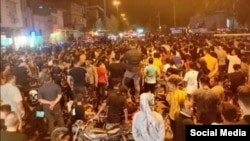On July 26, outgoing Iranian President Hassan Rouhani commented on a report about the situation in the country’s Khuzestan province, where there have been protests and civil unrest over a severe water shortage.
Rouhani, speaking to ministers during a cabinet meeting, said authorities have a duty to “listen to the protests” and also should be “humble and tolerant.” Ignoring the right to protest, he explained, would give Iran’s enemies a chance to exploit discontent.
“Civil protest is one of the fundamental rights of all members of the nation,” Rouhani stated.
Various Iranian officials have also promised to solve the water crisis in Khuzestan province while making similar claims about the right to protest. But these claims are misleading given Iran’s history, and they serve as a smokescreen to obscure the government’s violent response.
Reports from Khuzestan say security forces used live ammunition and tear gas and made arrests. Videos showed people in the streets shouting: “Water is my right!” and protesters throwing rocks and setting fires to block roads. Local sources said at least 10 people died. Hundreds were arrested, with police searching house-to-house.
The protests erupted in mid-July following shortages caused by drought and years of state mismanagement. Rainfall in Iran has dropped 50 percent from last year, and less water behind hydropower dams has also resulted in nationwide electricity shortages.
Critics say Iran diverted the course of Khuzestan’s rivers to other industrial areas.
The Office of the United Nations High Commissioner for Human Rights (OHCHR) said in a July 23 report that Khuzestan province, home to about 5 million people, mostly belonging to Iran’s Arab minority, used to be one of the most reliable sources of water.
The rights office also expressed concern about deaths and injuries during protests. “When you hear reports that injured protesters are avoiding hospitals for fear of being arrested, it is an indication of just how bad the situation is,” High Commissioner Michelle Bachelet said.
Because of tight security measures, the number of protesters killed and injured has yet to be confirmed, but local sources report put the number of deaths at 10, five of them confirmed, and the number of injured in the dozens.
On July 28, the Human Rights Activists News Agency (HRANA), a press association that monitors human rights in Iran, reported that the police opened fire on and used tear gas against protesters, and that security forces were heavily deployed in Khuzestan. The agency documented the arrests of 171 people across Iran, including 122 in Khuzestan.
Iranian journalist Hussein Razzaq said on Twitter that security forces went from one house to another in Khuzestan to arrest those who participated in the protests.
Human Rights Watch said that Iran’s authorities responded with “unchecked repression” and called on the government to immediately release imprisoned protesters and investigate deaths.
“As of July 28, human rights groups have verified the identities of at least nine people who were shot dead or died of injuries during the protests, including a 17-year-old boy,” Human Rights Watch said.
On July 23, Amnesty International said security forces used “deadly automatic weapons, shotguns with inherently indiscriminate ammunition and tear gas to disperse protesters.”
The group added that security forces opened fire on unarmed protesters, including children, injuring and killing several people and sending others to the hospital in critical condition. Intelligence agents swept up dozens activists from the Arab minority in mass arrests, Amnesty said.
“Iran’s authorities have a harrowing track record of using unlawful lethal force. The events unfolding in Khuzestan have chilling echoes of November 2019, when security forces unlawfully killed hundreds of protesters and bystanders but were never held to account,” the London human rights watchdog said.
The Center for Human Rights in Iran (CHRI), a consortium of journalists, researchers and human rights advocates, also cited deadly suppression, similar to what happened during those 2019 protests over high gas prices.
Iranian authorities have limited internet access during the protests. Netblocks, a global internet monitor, said on July 21 that mobile internet services had been disrupted in Iran starting on July 15. Iran “can severely limit access to information without the implementation of a total or national network blackout,” Netblocks said.
Iran’s state-owned Press TV claimed in a July 27 report that Iranian intelligence forces had arrested a "network" of agents linked to Israel’s Mossad spy agency on Iran’s western borders. The report said the network planned “to provoke urban riots and carry out assassinations.” However, it did not say how many people were apprehended or directly connect them to the Khuzestan protests.
The Press TV report did say that Iranian authorities deployed “additional security forces to the region to ensure the safety of the protesters” and that one police officer died in the violence. “The officer’s martyrdom clearly showed elements tied to foreigners had infiltrated the ranks of protesters in an attempt to provoke fake clashes and ignite riots,” Press TV said.







